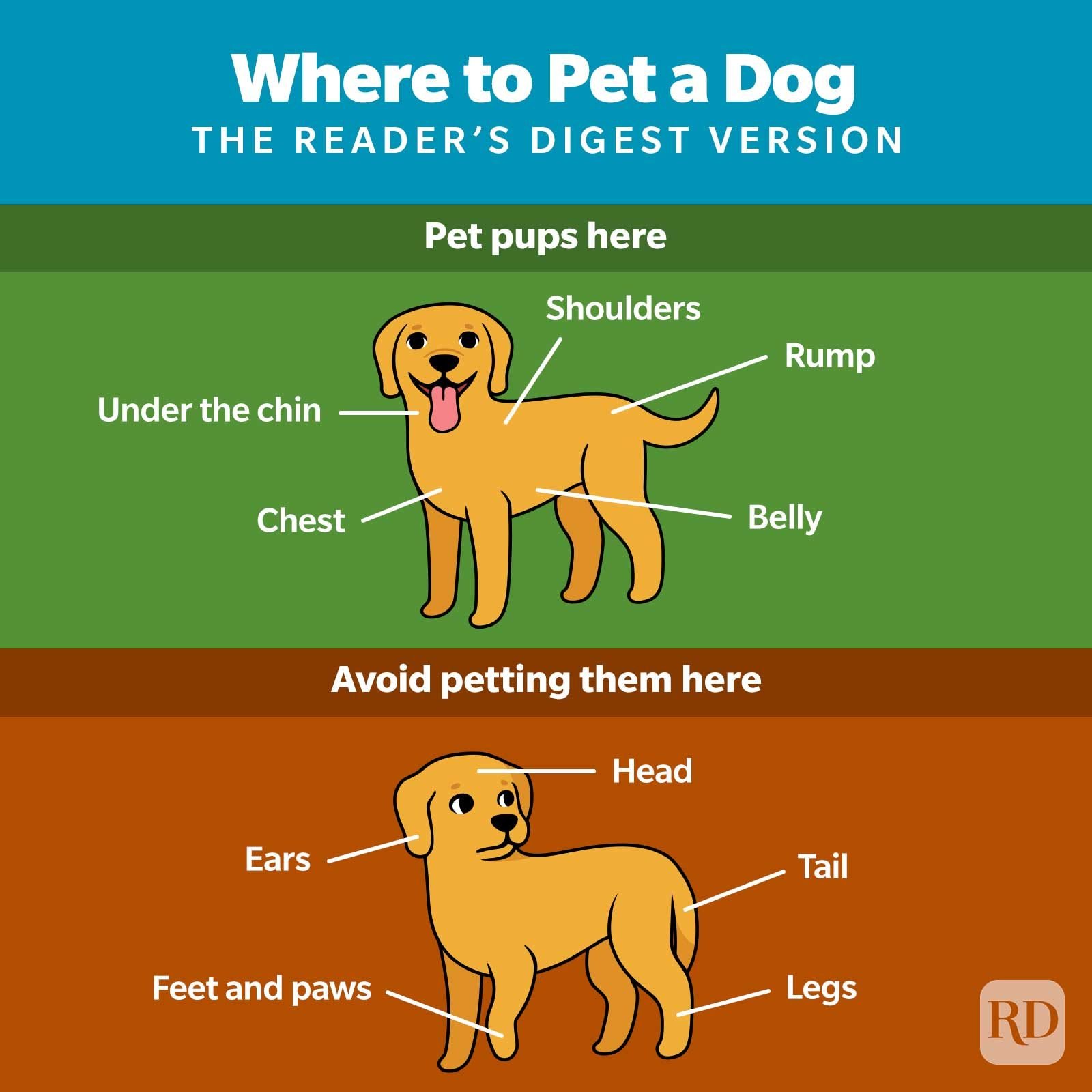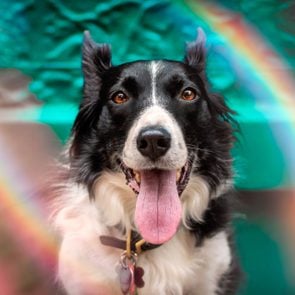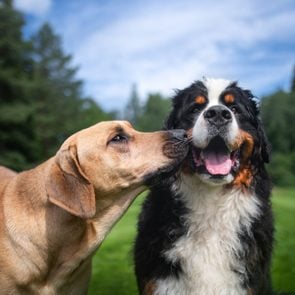Why Do Dogs Like to Be Petted?
Updated: Dec. 21, 2023

Find out the real reasons your dog likes to be petted so darn much
It’s so easy to lavish affection on our precious pups. We can’t resist kissing their cute faces, giving them belly rubs and scratching behind their ears. And they like it too—if we pause for just a second, they paw our hand in protest. It makes you wonder: Why do dogs like to be petted?
To get to the bottom of it, we chatted with experts in pet behavior. Heads up: The answer is even more fascinating than you might think. And if the info below gets the gears of your brain turning, sate your canine curiosity by learning about other dog behaviors, like why your dog stares at you, licks your feet or tilts its adorable doggy head. Could these be signs your dog needs affection? Read up to better understand your furry best friend.
While you’re at it, discover answers to common questions like “What is the reason for dog hiccups?”, “Why dogs drag their butts?” and “Why do dogs hate cats?”.
Get Reader’s Digest’s Read Up newsletter for more pet insights, humor, cleaning, travel, tech and fun facts all week long.
Why do dogs like to be petted?
In our hearts, we know the answer to “why do dogs like to be petted?” It feels good! But along comes science to confirm it. Research shows that when we interact positively, such as through cuddling and petting, both dogs and humans get a boost of oxytocin, the warm-and-fuzzy hormone.
But there’s another compelling reason dogs love petting. “Dogs are social animals, and the behavior that we call allogrooming [when animals of the same species groom one another] is quite common in social animals,” says Valarie Tynes, DVM, a veterinary behaviorist at the SPCA of Texas. Just think of the mutually beneficial grooming you see among monkeys at the zoo.
Grooming between humans and dogs, however, tends to be a one-way street. We groom our dogs, of course, but they don’t groom humans much—except when they lick us. When they do that, it’s basically the equivalent of them grooming us, says Dr. Tynes. “It’s very likely that this social grooming behavior evolved along with canine domestication,” she says.

Where are the best spots to pet a dog?
That depends. Dogs are individuals and have personal preferences when it comes to the places they want you to pet them. “My last few dogs liked to be petted on their rump, right above their tail head,” says Dr. Tynes. “My current dog prefers her chin and neck to be rubbed/scratched.”
Typically, the sweet spots are those they can’t reach on their own or areas where they won’t feel vulnerable. “One of the most important things to keep in mind when petting dogs is to let the dog tell you what it likes by paying attention to its behavior.” Try under the chin or on the rump, shoulders or chest. What about the coveted belly rub? Some dogs really dig this and find it delightfully ticklish, hence the scratch reflex or, less technically speaking, the cute puppy kicks that ensue. Other pups give it a hard pass.
Aside from making your pup feel good, petting can have a calming effect on stressed-out or anxious dogs (thanks, oxytocin). Give your four-legged friend a generous petting when stressful times arise, like before you leave the house or go to the vet. It just might help you relax too.
Where shouldn’t you pet a dog?
“In general, it’s a good idea to avoid petting/grabbing a dog’s tail, feet, legs, head and ears,” says Rachel Salant, an animal behavior specialist with Veterinarians.org. So why do dogs like to be petted in some areas but not others? Like humans, dogs are protective of their more sensitive body parts. On top of that, if your dog has had a bad experience during a nail trimming or you struggle to clean its ears, it may consider these areas off-limits to you.
Surprisingly, even though we’re naturally drawn to petting a dog’s head, it is actually one of the things your dog wishes you’d stop doing. Dogs inherently dislike it and feel threatened or stressed when a hand or something else hovers over their head. Think about it this way, says Dr. Salant: If you’re petting a dog and it retreats, it’s saying “no, thank you.” If it comes back for more, it’s telling you “I like that.”
Things to consider before petting a dog
When you’re walking down the street and see a super-cute pup, it’s hard to resist the urge to stop and pet it. But check out its body language first. “Even if the pet parent says the dog is friendly and loves to be pet, it’s a good idea to follow these tips to make sure they feel that way about you,” says Dr. Salant.
- Look at the tail. Is the dog’s tail wagging, standing straight or tucked between its legs? A dog’s tail broadcasts a host of emotions. A relaxed dog wagging its tail on the right is a friendly sign, research says.
- Check out the ears. You won’t get too much intel on dogs with floppy ears, but dogs with pointy ears that have pinned their ears way back are usually timid or fearful.
- Is the dog sniffing you? Before you reach out, give the pup time to investigate. Dogs seek information with their noses, but that doesn’t mean they want you to touch them.
- Watch its distance. When you move close to the dog, watch to see if it closes the distance while showing signs of being relaxed.
- Give its collar a glance. A red dog collar could be a fashion choice, but some parents choose it to let others know their dog is aggressive and needs some space. If it is wearing a red collar, look for the signs above and ask the pet parent before approaching the dog.
How to pet a dog
Before we get into the details, it’s important to note that humans have selectively bred dogs over thousands of years to favor traits we find useful, like the ability to bond, communicate and coexist with us. Still, that doesn’t mean every dog you meet wants affection from you, says Dr. Salant. Even affectionate dog breeds might not want to be petted by you. For the dogs that do like to be touched, follow the tips above and the steps below to pet a dog correctly.
- Don’t make direct eye contact until you’ve confirmed the dog is interested in interacting with you.
- Avoid bending over at the waist and reaching over the dog’s head.
- Offer your hand and approach from the side, not straight at its face. Reach for the dog’s shoulder so the dog can clearly see where your hand is going. Scratch for two to three seconds. If the dog doesn’t move away, try slowly raising your hand to the dog’s ears and scratch those for a few seconds, then stop.
- If the dog doesn’t actively pursue you, or even moves away from you, it’s just not that into you. If it leans in and nudges you, it’s telling you what it wants: more petting.
Sources:
- Valarie V. Tynes, DVM, veterinary behaviorist at the SPCA of Texas
- Rachel Salant, an animal behavior specialist with Veterinarians.org
- Animals: “The Role of Oxytocin in the Dog-Owner Relationship”
- Current Biology: “Asymmetric tail-wagging responses by dogs to different emotive stimuli”






















